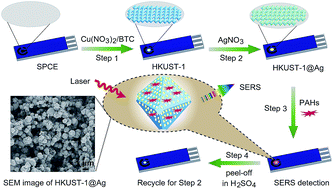当前位置:
X-MOL 学术
›
J. Mater. Chem. A
›
论文详情
Our official English website, www.x-mol.net, welcomes your
feedback! (Note: you will need to create a separate account there.)
Facile in situ synthesis of core–shell MOF@Ag nanoparticle composites on screen-printed electrodes for ultrasensitive SERS detection of polycyclic aromatic hydrocarbons†
Journal of Materials Chemistry A ( IF 10.7 ) Pub Date : 2019-05-17 00:00:00 , DOI: 10.1039/c9ta03690c Dan Li 1, 2, 3, 4 , Xiukai Cao 1, 2, 3, 4 , Qinmei Zhang 1, 2, 3, 4 , Xingang Ren 4, 5, 6, 7, 8 , Lei Jiang 4, 9, 10, 11 , Dawei Li 4, 9, 10, 11 , Wei Deng 1, 2, 3, 4 , Haitao Liu 1, 2, 3, 4
Journal of Materials Chemistry A ( IF 10.7 ) Pub Date : 2019-05-17 00:00:00 , DOI: 10.1039/c9ta03690c Dan Li 1, 2, 3, 4 , Xiukai Cao 1, 2, 3, 4 , Qinmei Zhang 1, 2, 3, 4 , Xingang Ren 4, 5, 6, 7, 8 , Lei Jiang 4, 9, 10, 11 , Dawei Li 4, 9, 10, 11 , Wei Deng 1, 2, 3, 4 , Haitao Liu 1, 2, 3, 4
Affiliation

|
This paper reports the fabrication of a highly sensitive and reusable substrate for surface-enhanced Raman scattering (SERS) analysis. Core–shell metal–organic framework (MOF; HKUST-1)@Ag nanoparticles (NPs) are prepared on a screen-printed carbon electrode (SPCE) via in situ electrodeposition. The morphology and Ag coverage of core–shell structures can be easily controlled by electrodeposition potential and time without substrate motion. The HKUST-1(Cu)@Ag composites combine abundant SERS “hot spots” among the high-density Ag NPs and the excellent adsorption performance of the MOF, resulting in effective pre-concentration of analytes in close proximity to these “hot spots” and enhancement of SERS sensitivity. The optimized polyhedral HKUST-1@Ag structures exhibit high SERS activity for detecting 4-aminothiophenol at a concentration as low as 5 × 10−10 M. More importantly, the polyhedral HKUST-1@Ag composites provide high sensitivity for detection of polycyclic aromatic hydrocarbons (PAHs) while preserving the cyclability and selectivity required for reliable quantitative analysis. The method is effective over a wide range of PAH concentrations (0.5 nM to 0.5 M), with detection limits as low as hundreds of pM. This study offers a new method to tailor the structure of MOF-based SERS substrates for on-site screening or point-of-care applications.
中文翻译:

容易原位核壳MOF的合成@对超灵敏SERS检测多环芳烃的丝网印刷电极Ag纳米颗粒复合材料†
本文报道了一种用于表面增强拉曼散射(SERS)分析的高度敏感且可重复使用的基材的制造方法。通过丝网印刷的碳电极(SPCE)原位制备核-壳金属-有机骨架(MOF; HKUST-1)@Ag纳米颗粒(NPs)电沉积。可以通过电沉积电位和时间轻松控制核-壳结构的形貌和Ag覆盖,而无需基板运动。HKUST-1(Cu)@Ag复合材料结合了高密度Ag NP中丰富的SERS“热点”和MOF的出色吸附性能,从而在这些“热点”附近有效地进行了分析物的预富集。和增强SERS敏感性。优化的多面体HKUST-1 @ Ag结构在低至5×10 -10的浓度下表现出高的SERS活性,可检测4-氨基苯硫酚M.更重要的是,多面体HKUST-1 @ Ag复合材料为检测多环芳烃(PAH)提供了高灵敏度,同时保留了可靠定量分析所需的循环性和选择性。该方法在广泛的PAH浓度范围(0.5 nM至0.5 M)中有效,检测限低至数百pM。这项研究提供了一种新方法,可针对现场筛选或现场护理应用量身定制基于MOF的SERS底物的结构。
更新日期:2019-05-17
中文翻译:

容易原位核壳MOF的合成@对超灵敏SERS检测多环芳烃的丝网印刷电极Ag纳米颗粒复合材料†
本文报道了一种用于表面增强拉曼散射(SERS)分析的高度敏感且可重复使用的基材的制造方法。通过丝网印刷的碳电极(SPCE)原位制备核-壳金属-有机骨架(MOF; HKUST-1)@Ag纳米颗粒(NPs)电沉积。可以通过电沉积电位和时间轻松控制核-壳结构的形貌和Ag覆盖,而无需基板运动。HKUST-1(Cu)@Ag复合材料结合了高密度Ag NP中丰富的SERS“热点”和MOF的出色吸附性能,从而在这些“热点”附近有效地进行了分析物的预富集。和增强SERS敏感性。优化的多面体HKUST-1 @ Ag结构在低至5×10 -10的浓度下表现出高的SERS活性,可检测4-氨基苯硫酚M.更重要的是,多面体HKUST-1 @ Ag复合材料为检测多环芳烃(PAH)提供了高灵敏度,同时保留了可靠定量分析所需的循环性和选择性。该方法在广泛的PAH浓度范围(0.5 nM至0.5 M)中有效,检测限低至数百pM。这项研究提供了一种新方法,可针对现场筛选或现场护理应用量身定制基于MOF的SERS底物的结构。











































 京公网安备 11010802027423号
京公网安备 11010802027423号